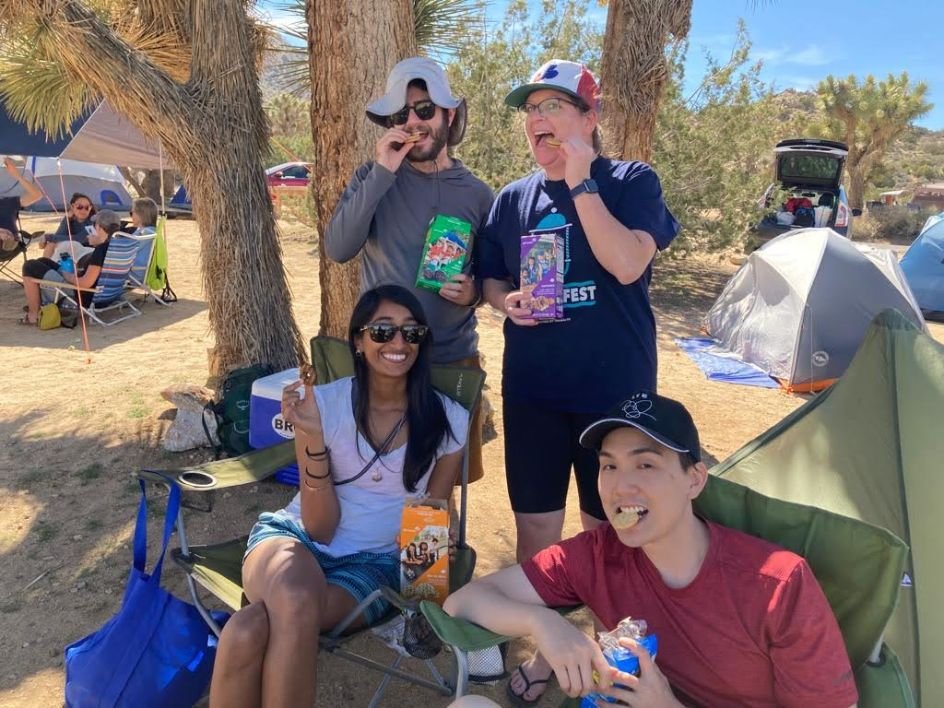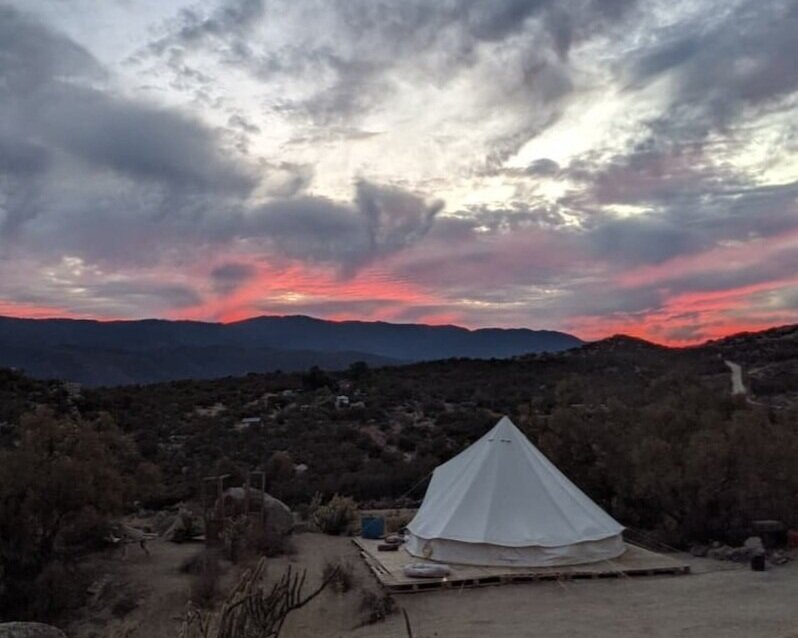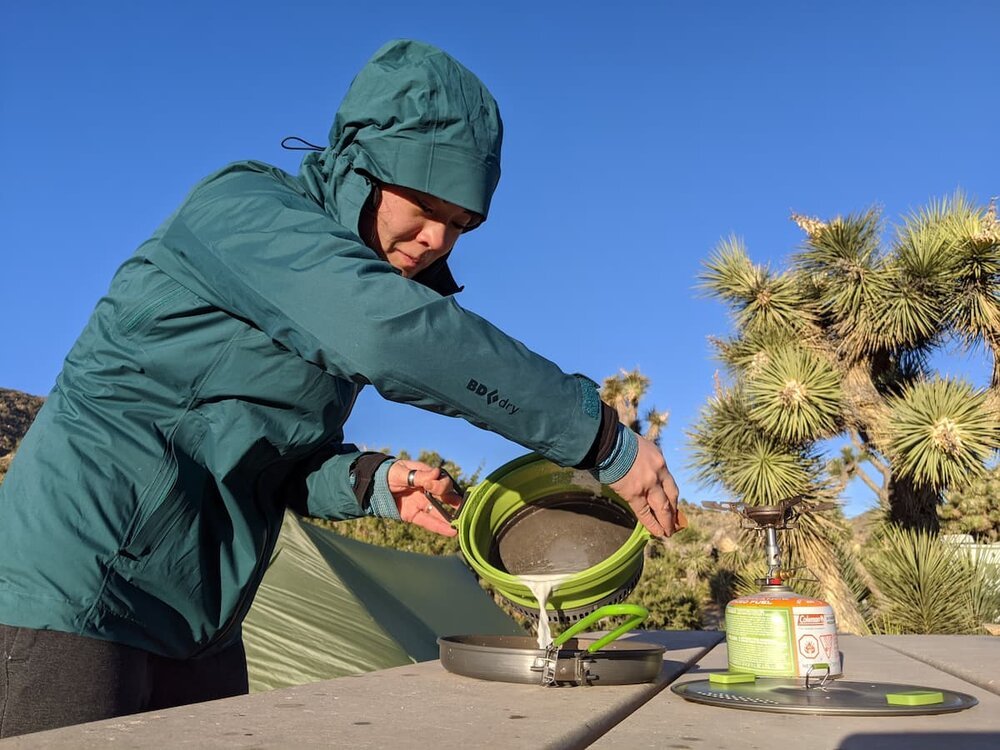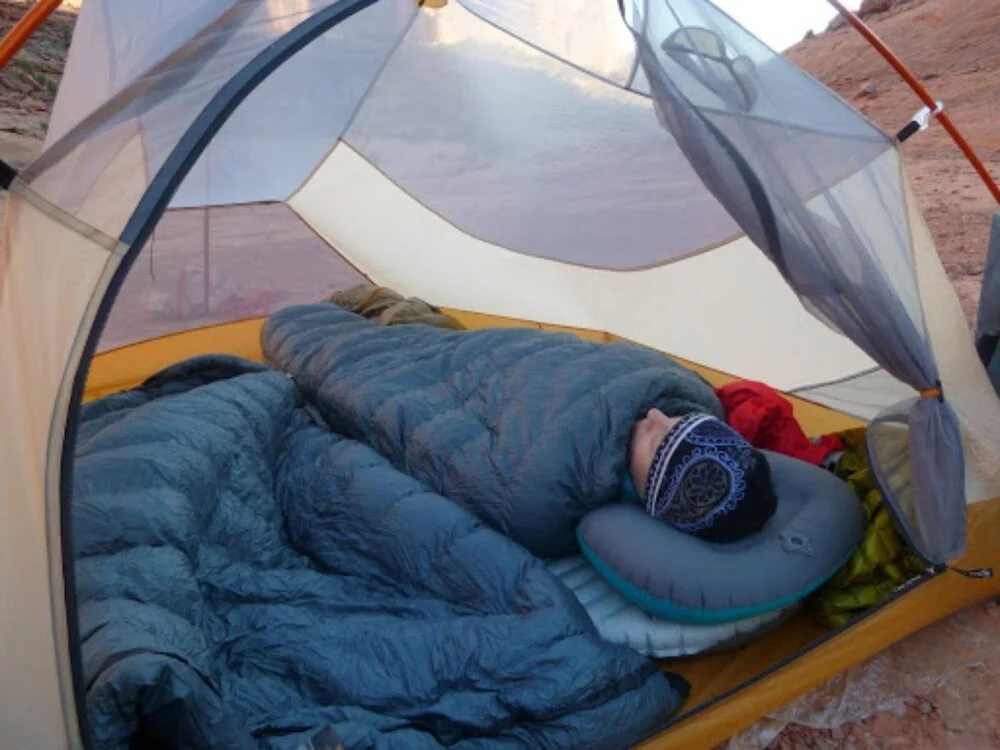How to Get Started Camping
A Beginner’s Guide to your First Camping Trip
Once you have experience walking trails and you feel like exploring even more, you might want to spend your first night camping outdoors. We recommend you start by camping at a designated campsite at a campground where you’ll have easy access to your vehicle, bathrooms, picnic tables, fire pits, and even potentially electricity.
Camping is also a relatively inexpensive outdoor activity that is accessible to people of many ages and abilities. Camping at a campground is a great way to start spending more time outdoors because you’ll have access to bathrooms and other amenities and the help of your campground host. Plus, if you’re camping by your car, if any of your gear fails, it's much easier to return home or find another safe place to spend the night than if you were backpacking. These are our tips for having a successful camping experience that will leave you wanting to get outside even more.
En Español: Los primeros pasos para acampar con éxito
Related: A Beginner’s Guide to Hiking
CAMPING GEAR CHECKLIST
| CAMPING GEAR | OUR PICK(S) | MORE OPTIONS |
|---|---|---|
| Main Gear | ||
| Waterproof tent | Waterproof tent | Best Camping Tents |
| Gourndsheet or tarp | Gourndsheet or tarp | |
| Sleeping bag | 40ºF or lower sleeping bag | |
| Mattress/ sleeping pad | Inflatable air mattress for car | Best Camping Mattresses |
The size and design of tents and sleeping bags varies (and so does the price!). This is a backpacking-style tent. Below are some tips on how to find the best one for your upcoming trips. Photo by Naomi Hudetz.
MAIN GEAR
Sleeping bag for each person
Sleeping clothes (or pajamas)
Headlamp and/or lantern
Pillow (from your bed or inflatable travel pillow)
Camping tent stakes (or tent pegs) and poles
Groundsheet (a tarp or other plastic sheet to put under your tent for protection. Some tents include a footprint sized exactly to the tent's dimensions)
Camping stove, cookpot, utensils — check out our guide to Best Camping Stoves and Grills for more
Positive attitude
OPTIONAL GEAR
Layers of clothing
Water jugs for drinking, cooking, washing, and extinguishing fires
A camping activity like games, a storytelling topic, or fishing gear
A camper setting up his tent on his first camping trip! Photo by Liz Thomas.
Essential Camping gear tips: What to Look For and camping gear Rentals
In some places, you can rent camping essentials like your tent, sleeping bags, and sleeping pads. But if that’s not the case near you, research your options before buying. See if friends or family have camping equipment to lend you. Some youth and community groups and even libraries have camping gear you can borrow. If you have no choice but to buy camping gear, consider the following:
A sleeping bag set up in a camping and backpacking style tent. Photo by Liz Thomas
Sleeping bag
Here are some tips for choosing a sleeping bag.
WHERE DO YOU LIVE? WHERE DO YOU PLAN TO EXPLORE NOW AND IN THE FUTURE?
If you live in a warm place, or only car camp in the summer, you may not need a cold-weather sleeping bag, so a 40ºF (or lower) rating will do. If you live in a mountainous place and/or plan to travel more in the future, consider a bag with a rating of between 15ºF and 32ºF. Having a warm enough bag can make or break your trip, so if you're not sure you bag is warm enough, bring a blanket to add just in case.
HOW MUCH DOES WEIGHT MATTER IN A SLEEPING BAG?
In any case, you don't necessarily need the lightest bag for car camping. Outdoor adventure stores have a good selection of sleeping bags of good quality, weight, and temperature rating. Treeline Review is still writing a car camping sleeping bag story, but we can direct you towards our Backpacking Sleeping Bag guide. Backpacking sleeping bags tend to be lighter weight than car camping sleeping bags, and thus, more expensive. They certainly work well for car camping, but when you’re car camping, you’ll likely be just as happy choosing a less expensive bag with the same warmth rating.
CAN I RENT A SLEEPING BAG?
A few REI stores offer rental gear so that you can try various types and sizes of tents. It’s always a good idea to try before you buy, if you can.
This is a typical car camping tent—it’s large enough for 2-3 people, but it’s heavy. This heaviness makes it durable, so it will last many trips of going in-and-out of the car. The tent is pitched on a flat space, under large trees, and free of sharp debris. Photo by Felicia Hermosillo.
Camping Tent
Here are some tips and questions to ask yourself about a camping tent. Many camping tents (including rentals) come with the tent stakes (tent pegs), guyline, rain fly, and footprint (groundsheet), but always check before heading out.
HOW BIG OF A TENT DO I NEED FOR CAMPING?
When purchasing a tent, consider how many people (and pets!) will share the tent with you. Before buying or renting, I recommend marking out the tent’s dimensions on your floor with tape and lying down inside to get an idea of how small or large the tent is. Solo camping doesn't require a big tent. But for family camping, you'll want a tent that can fit everyone (and any bedtime items you may want inside the tent). Treeline Review’s Best Camping Tents guide has recommendations on what to look for.
Related: read about one of our favorite dome camping tents in our long-term Mineral King review.
WILL I ALSO WANT TO USE THIS TENT FOR BACKPACKING?
If you want to go on a backpacking trip in the future, and you only want to invest in one tent, make sure you choose a lightweight tent that’s appropriate for backpacking, too. Backpacking tents are usually very different from car camping tents, in shape, size, and (unfortunately) price. Camping tents tend to be bigger and more durable, but heavier. See Treeline Review guide to the Best Backpacking Tents for models we like.
PRACTICE SETTING UP YOUR TENT
Whether your tent is new or borrowed, always set it up before you go on your camping trip. Knowing how to set up your tent before you go prevents frustration when you arrive at camp late or it’s raining and you need to set up your tent quickly.
Some campgrounds offer already set-up canvas tents for you to sleep in. This means you won’t have to purchase or rent a tent before your trip. While some canvas tent campgrounds are “glamping” and can be expensive, others are relatively affordable. Photo by Liz Thomas
DOES PRICE, SIZE, OR WEIGHT MATTER THE MOST TO YOU?
Compare the size with the price and the weight. You’re likely to find two of the three attributes you’re looking for. If it’s big and lightweight, it’s going to be expensive. Even if it’s small and cheap, it’s probably going to be heavy. Most camping-specific tents will be bigger and heavier, but durable. Figure out your personal priorities before buying.
CAN I RENT A TENT?
Some gear stores, like REI, offer rental gear so that you can try various types and sizes of tents. It’s always a good idea to try before you buy, if you can.
A group of campers gathered around a built-in firepit at a campground. Photo by Liz Thomas
CAMPING TIPS FOR OTHER GEAR
Bring a comfortable camp chair for lounging. See our Best Camp Chairs guide for recommendations. If the weather is chilly at night, a camp blanket is another great accessory to have!
Bring a few layers of clothing in case of cold evenings. While a Down Jacket or Synthetic Insulated Jacket are nice, sweatshirts or heavier jackets work fine.
A camp stove may be nice, but it's not necessary. Bring food that is easy to prepare and that does not require too much clean-up. Some people opt for sandwich making material. If your campground has a firepit, you can heat up burritos or make grilled cheese easily.
For our two-night camping trip, we brought several coolers to keep items like cheese, vegetables, and drinks.
Consider bringing a camping cooler or ice chest. If you will be out for a few days, you will want a way to keep perishable items from spoiling and drinks cold.
Bring a water jug. This will make it easier for you to carry water when you go to the campground’s faucet (you’ll likely be sharing one faucet with several other groups). Otherwise, bring your own water if there is none provided. If you're bringing your own water, you'll want at least two gallons per person to account for drinking water, cooking, and cleaning up. If you plan to do any hiking, bring more.
Bring enough water to extinguish a fire. If you plan to make a fire, bring enough water to extinguish it, in addition to water for your personal consumption. Small campfires require about five gallons of water to extinguish fully.
Bug spray or bug lotion. A necessity if you will be camping in a buggy area.
A camping activity! This can be a game, musical instrument, or some good stories.
A way to carry your camping gear. Many repeat campers use a hardsided plastic container as their camp box. You can also use a cardboard box. You will want to minimize the amount of trips between your picnic table and car and a box can help.
Bring a backcountry road emergency car repair kit. It’s cheaper than a tow truck!
CRITERIA FOR CHOOSING A CAMPING AREA
As a beginner camper, one question you may have is "Where can I camp?" Here are some suggestions to help make your first camping trip easier. As you gain more skills and experience, you'll learn how to camp without amenities as you will do on a backpacking trip.
Before our camping trip, our friends gathered to practice setting up tents in our backyard.
practice camping in a backyard
If you have access to a backyard, that's a great choice (and inexpensive option) for a first camping trip, as you'll have easy access to toilets and running water and can always sleep inside if the weather turns.
If sleeping in a backyard doesn’t excite you, plan to spend an evening practicing setting up camp gear in a friend’s backyard. Before our camping trip in Joshua Tree National Park, we practiced setting up camping tents and then ate s’mores next to a backyard fire pit. It was a good way to mentally prepare for the trip we were about to take together.
Having a campsite with a picnic table makes it easier to cook, eat, and play games. It also means you don’t need to bring camp chairs. Photo by Liz Thomas
CHOOSE AN ESTABLISHED CAMPGROUND
Another good option for your first camping trip is a campground with toilets (and maybe even showers).
While camping for the first time, it's nice to have toilets so you have one less skill to worry about. Additionally, established campgrounds will often have camp hosts who can help you. Established campgrounds are also more likely to have other visitors. This may not be ideal if you seek solitude, but can provide some comfort that you are not alone.
SHOWERS
If you plan to use the campground showers, wear flip flops to avoid fungus/foot infections from the floor of the showers. We wouldn't recommend taking a shower with your hiking shoes or hiking boots!
Built-in grills and fire pits can be a great amenity available at many campgrounds. We prepared vegetables on a stick for one of our dinners in camp.
PICNIC TABLES
Choose a site with a picnic table or two for easy eating.
GRILLS OR FIRE PITS
Although many campgrounds have cooking grills and fire pits, I don’t recommend using them for camp cooking. Crumbs, smells, and leftovers attract animals. It’s better to take already prepared food or food you can prepare easily on a camping stove. Save the fire pit for a campfire.
Respect Site Restrictions
Also, it can be nice not to feel so alone, but if you plan to camp with others, it’s important to respect the site restrictions on the number of people, tents, and cars in one campsite.
A Self-Service pay station campground at a remote campground has you deposit cash into an envelope. These types of camps are first-come, first-served and do not have a camp host. Photo by Felicia Hermosillo.
How to choose a campsite
Once you’ve figured out where you’d like to go car camping, you have to choose a specific site. Here are some campsite selection tips.
At some state and local campgrounds, as well as in national forests and national parks, reservations must be made online, and you’ll pay and choose your site before you arrive. You will be assigned a campsite number. When you get to your campsite, you can use a map to find the campsite with the number you have been assigned.
Camping can be a relatively inexpensive way to travel and get outside. This remote campground was in an area where there are no hotels in many miles. Camping gave us the freedom to see places we otherwise may not have visited. Photo by Felicia Hermosillo.
In other places, you pay on arrival: most of these places do not accept credit or debit cards, so you’ll want to bring a check or exact change in cash.
In some places, dispersed camping is free, but has no services—trash, toilets, showers, or picnic tables. However, dispersed camping is not legal in many places.
Whatever the case, make sure to look up the rules before you go, to avoid unpleasant surprises.
If you get to choose your campsite on arrival, choose a site that’s mostly flat and has trees, which will protect you from the sun and the elements. Before you set up, check the campsite for trash or abandoned food scraps, which can attract animals. If there is garbage and/or food, you can clean the site using gloves and a trash bag. Or, if another site is available, you can switch sites.
Set down a tarp below your camping tent to protect it from sharp rocks. Photo by Felicia Hermosillo.
WHAT TO DO WHEN YOU GET TO YOUR CAMPSITE
Before you set up your tent, you’ll want to clear the ground where you’ll put the tent, removing sticks, stones, pine cones, and other things that can damage the floor of the tent and/or the inflatable mattress.
Spread out the tarp, groundsheet, or tent footprint. Get on all fours, and run your hands gently over the entire groundsheet, double-checking for anything sharp.
When you set up and stake out your tent, make sure you have a taught pitch—there should be no sagging or wrinkles on any surface of the tent. Dimples and wrinkles let water in if it rains, and the sagging material will be loud in the wind.
A car camping tent for two with inflatable mattress, inflatable pillow, Katabatic Gear sleeping bag, and extra warm layers.
How to Set Up the Inside of Your Tent
Now that your tent is set up, it's time to make your nest inside.
Check the floor one more time to make sure there is nothing sharp underneath the tent before blowing up your air mattress or sleeping pad.
Lay your sleeping bag on top of our sleeping pad and arrange your pillow(s!) to get cozy.
The author, Felicia Hermosillo, at a wild campsite in New Mexico. Camping gives us access to some of the most beautiful places. Leave No Trace is a way to ensure that these places stay just as beautiful for generations to come. Photo by Lawton Grinter.
Car camping etiquette
Even if you are not camping in remote wilderness campsites, it’s important to follow Leave No Trace guidelines. Here’s how they apply to camping in a campground:
Leave No Trace Guidelines for Outdoor Areas
PLAN AHEAD AND PREPARE
Reserve your campsite and arrive with enough daylight left to pitch your tent and set up camp without using your headlights. For your first camping trip, we'd recommend not winter camping. Instead, check the weather forecast and choose a snow-free, rain-free day.
TRAVEL AND CAMP ON DURABLE SURFACES
Use the campsites provided and follow the local regulations around things like not cooking on tent pads (a designated camping spot in a site that’s built flat for a tent) and leaving provided tables where they are.
Even small pieces of trash can be harmful to wildlife and make a campsite less appealing. The author found these at a campsite. Photo by Felicia Hermosillo
DISPOSE OF WASTE PROPERLY
While camping and before you leave, be sure to remove all trash (even trash you found on arrival!) and any crumbs.
If you need to wash dishes on-site, it’s important to throw the crumbs in the trash (you can use a strainer to collect food scraps). Use biodegradable soap, such as Dr. Bronners, which we recommend in our Eco-Friendly Gear guide.
LEAVE WHAT YOU FIND
Don't break limbs off of trees, and do not pick flowers or plants around your camping area. This preserves nature for those who will use the site after you.
MINIMIZE CAMPFIRE IMPACTS
A poorly maintained camp fire ring can leave campsites look less appealing. Photo by Felicia Hermosillo.
Review campfire restrictions before you go. In many places, campfires are prohibited in the summer due to drought conditions or the impact that an out-of-control wildfire might have.
Most established campgrounds have a campfire ring. If your campground has a fire ring, only make fires in the fire ring.
If you can legally make a campfire, make sure it’s COMPLETELY extinguished before you head to bed. Use a stick to mix the ashes with water to extinguish embers.
Do not throw garbage in the campfire. Not only does this smell bad, but it’s also likely to attract bears and other bothersome nighttime wildlife.
In some places, you can’t bring firewood in from other places—and it may or may not be legal to gather firewood in the area. Research the regulations in the place you’re camping, and make a plan to buy firewood locally.
RESPECT WILDLIFE
Don't feed the wildlife! This often results in animals becoming aggressive around food, needing to be euthanized, or starving over the winter, when people aren’t camping.
Keep pets on a leash so they don't chase wild animals—this is their home, and we’re all visitors.
Keep food in the car when not in camp and at night.
BE CONSIDERATE OF OTHER VISITORS
Respect quiet hours—speak quietly during these times.
If you want music, play music outside of quiet hours at a low volume so as not to interfere in others’ experiences.
Respect alcohol regulations.
Be friendly to neighbor campers!






















